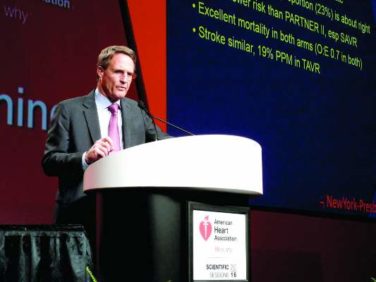AT ASTRO ANNUAL MEETING 2016
BOSTON (FRONTLINE MEDICAL NEWS) – Patients with stage II or III non–small-cell lung cancer with comorbidities that make them poor candidates for surgery or chemotherapy may still benefit from accelerated hypofractionated radiation, an interim analysis of a randomized trial suggests.
Among 48 patients followed for a median of 24 months, there were no statistical differences in either overall survival (OS) or progression-free survival between patients with stage II or III NSCLC and poor performance status treated with either conventional radiation delivered over 6 weeks, or image-guided radiation therapy (IGRT) delivered over 3 weeks, reported Puneeth Iyengar, MD, PhD, of the University of Texas Southwestern in Dallas.
“We would argue that a curative approach with accelerated hypofractionated radiation alone offers similar OS and PFS compared to conventional radiation in a population of patients that cannot receive their standard of care treatments,” he said at a briefing at the annual meeting of the American Society for Radiation Oncology.
“There is limited grade 3-5 toxicity, and as importantly, and more important to patients, is that the treatment time is cut in half and may be acceptable to the patient as well as to the treating physician,” he added.
The investigators are hopeful that the study, when completed, will “change the paradigm of how we treat these patients who can’t receive the standard-of-care treatment.”
The UT Southwestern investigators had previously shown in a phase I dose-escalation study that treating patients with 60 Gy delivered in 15 fractions instead of the conventional 30 fractions did not increase treatment-related toxicity,
In the current study, they explored the question of whether accelerated hypofractionated radiation therapy could improve survival in a difficult-to-treat population.
They have enrolled to date 60 patients with stage II or III NSCLC and Zubrod performance status of 2 or greater.
In arm A, 28 patients were assigned to receive conventional radiation at total doses of 60 to 66 Gy delivered in 30-33 fractions of 2 Gy each, In arm B, 32 patients were assigned to receive a total dose of 60 Gy delivered in 15 fractions of 4 Gy each.
The median age was 68 in both arms. The male-to-female ratio was equal in arm A, but 4:1 in arm B, The distribution of tumor types was equally weighted in each arm, with squamous cell carcinomas accounting for 53% of lesions, and adenocarcinomas accounting for the remainder.
Among all 60 patients, 53 presented with stage III disease, and 7 with stage II.
Of the 60 patients, 48 had follow-up sufficient for interim evaluation, and of this group, 27 (56%) were alive at last follow-up.
Median OS on Kaplan-Meier analysis was 11.5 months, with no statistical differences between the groups (per-group rates were not shown), Median PFS was 14 months, also with no statistical differences.
There were three deaths from hypoxia possibly related to radiation, two in the conventional fractionation arm, and one in the IGRT, accelerated fractionation arm. There were 10 grade 3 radiation-associated toxicities in arm A, and 6 in Arm B. There were no grade 4 toxicities in either group.
George Rodrigues, MD, of London (Ontario) Health Sciences Center, who moderated the briefing, said that in addition to patients with poor performance status, there are some patients who simply do not want to undergo chemotherapy, and for these patients the efficacy, low side effects, and convenience of accelerated fractionation radiation therapy may prove to be a good treatment option.




